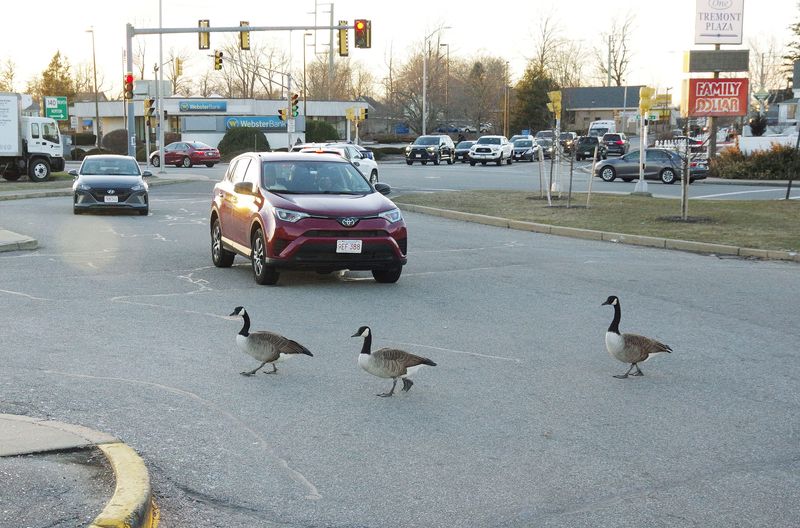
A driver struck and killed several geese in New Jersey, and police are trying to find out if it was done intentionally to the birds, which often become victims of fatal road encounters but are protected by wildlife laws.
Police responded to reports of a vehicle striking multiple geese that were crossing the road at about 6:45 p.m. on July 14 and discovered seven geese dead in Spotswood, New Jersey, a community of just over 8,000 people about 40 miles outside New York City. The driver of the vehicle left the scene, the Spotswood Police Department said in a statement. The department is reviewing surveillance footage and asking for witnesses to come forward.
It's not yet clear whether the driver intentionally or accidentally struck the geese, the department said, noting that it could violate state and federal regulations to hurt geese on purpose.
“We take all incidents involving wildlife seriously, especially those that may involve intentional harm to the animals,” Captain Edward Schapley said.
A review of news articles and government reports reveals that collisions with wildlife, especially geese, happen relatively frequently across the United States in roadway encounters that are sometimes deemed intentional. In June, a community in Wichita, Kansas, was unsettled by seven geese left dead in a road, KAKE reported. Two weeks later, a car chase with a driver in a stolen vehicle ended in a crash into a fence and 12 dead geese, the sheriff's office in Dorchester County, South Carolina, said. Two summers ago, as a group of people used their cars to stop traffic to help a gaggle of 150 to 200 geese cross a road in Henderson, Nevada, a driver went around them and struck at least nine geese, a witness told ABC affiliate KTNV.
So, what should you do if you encounter geese or other animals blocking the road? Here's what to know:
How common are car collisions with wildlife?
Tens or even hundreds of millions of birds are believed to be killed each year in collisions with cars in the U.S., researchers found in a study published in the Journal of Wildlife Management in 2014. Cars hitting birds may even contribute to population declines for some species, the study authors found.
While birds may not cause much damage to cars, larger animals certainly do. Somewhere between 1 and 2 million crashes between vehicles and large animals like deer happen every year in the country and the number appeared to be on the rise, according to a 2008 report by the Department of Transportation's Federal Highway Administration. Some 200 human lives are lost and 26,000 people are injured annually in these collisions, which also cause about $8 billion in damages per year, the report found.
Animals may try to cross roads to reach food, water or shelter, experts say. Most animals can cross roads with low traffic with little problem, but as traffic increases, more collisions occur and animals may grow to avoid busy roads, isolating them from other animals and habitats on the other side, according to the Washington State Department of Transportation.
"The peak time to hit deer in Utah is around November," according to Utah Division of Wildlife Resources Migration Initiative Coordinator Daniel Olson.
The timing coincides with mating season, when more deer are likely to be crossing roads during migration or to find mates, Olson said. Lower visibility in the dark when Daylight Saving Time ends also contributes to collisions, he said.
What to do when you see animals blocking the road
While driving, be on the lookout for signs indicating that wildlife are known to cross the road. If you see a group of animals attempting to cross a road or blocking a road, you should not intentionally drive into them, wildlife experts and advocates say.
Human safety is of the utmost importance, so you should only stop if it is safe to do so, the nonprofit Defenders of Wildlife said. If it is safe, brake firmly, but be careful not to cause your brakes to lock up so you don't lose control. Don't swerve or leave your lane to avoid an animal, the group said, noting that many accidents happen when someone swerves to avoid animals and hits oncoming traffic or a stationary object like a tree.
If a group of animals is crossing the road, don't try to drive through them or get out of your car. You can try flashing your lights or honking your horn to encourage them to move out of the way, Defenders of Wildlife said. Once they move, drive cautiously until you clear the area.
If the animal in the road is a slow-moving turtle and you need to move it for safety, help it cross in the direction it was going. You can use a car mat or other flat surface to avoid picking it up with your hands, the U.S. Fish and Wildlife Service said.
If you do hit an animal, you should pull over and use your flashers, flares or reflective triangles if you have them to warn other drivers, Defenders of Wildlife said. Contact police, state wildlife and transportation agencies to report the collision. Don't try to approach an injured animal, because it may bite or kick you.
Geese, other wildlife are protected under federal law
Geese, including the commonly seen Canada goose, are protected under the Migratory Bird Treaty Act of 1918, which prohibits the intentional harm or killing of many species of birds. Intentionally hitting them with a car can violate both state and federal regulations, the Spotswood Police Department said.
Efforts to protect wildlife that tend to cross roadways have included installing wildlife crossings, which are human-made structures like tunnels or bridges intended for animals to use to cross busy and dangerous roads. These crossings can range from small tunnels for amphibians to box culvert structures for larger mammals like deer.
Several states, including California, Florida and Colorado have passed legislature to install wildlife crossings or assess how new road infrastructure will impact wildlife migration patterns, according to the National Conference of State Legislatures.
Signs warning drivers that an area is known for frequent wildlife crossings can also help, the Toronto Wildlife Centre said on its site.
This article originally appeared on USA TODAY: Can roadkill be a crime? This police department says yes.
Reporting by Jeanine Santucci, USA TODAY / USA TODAY
USA TODAY Network via Reuters Connect

 USA TODAY National
USA TODAY National
 WKYT
WKYT America News
America News Local News in Pennsylvania
Local News in Pennsylvania Law & Crime
Law & Crime MPR News Crime
MPR News Crime The Kansas City Star Crime
The Kansas City Star Crime FOX 13 Tampa Bay Crime
FOX 13 Tampa Bay Crime Slate Magazine
Slate Magazine